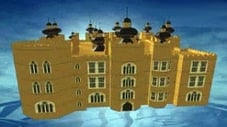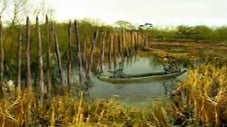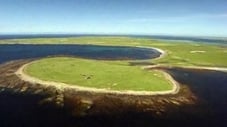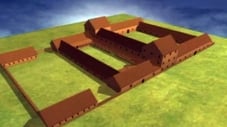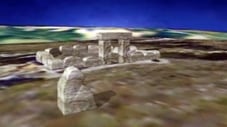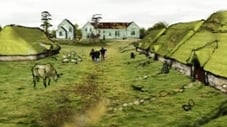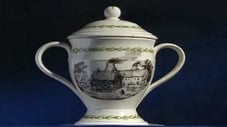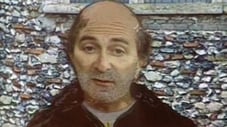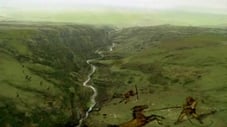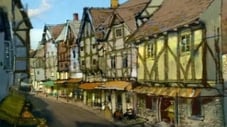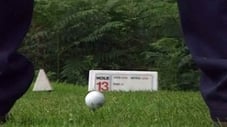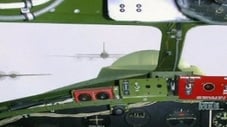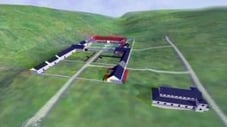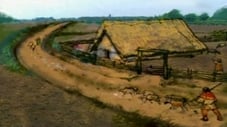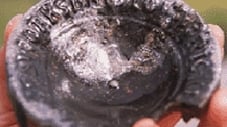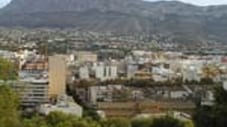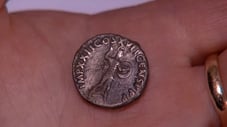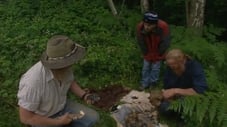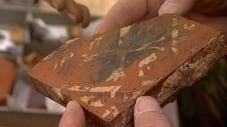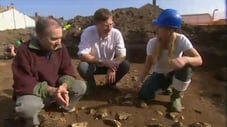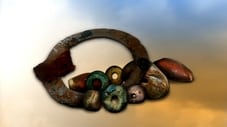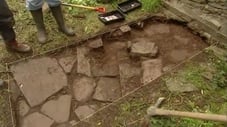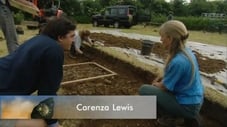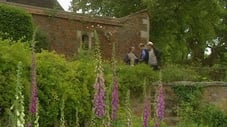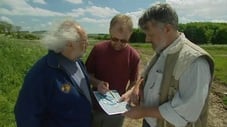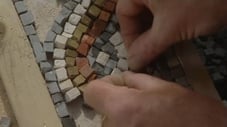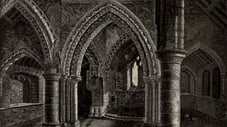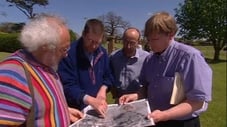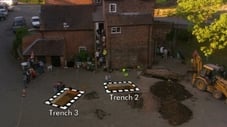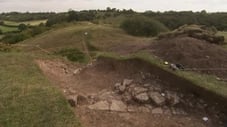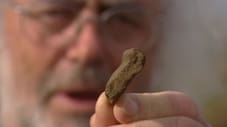
Time Team (1994)
← Back to main
Robin Bush as Self - Historian
Episodes 60
Richmond Palace - Richmond, Surrey
Filmed between 25 and 27 July 1997. The team are camped on an immaculate suburban lawn next to the Thames. They are searching for the now vanished Richmond Palace, site of the death of Elizabeth I. But amazingly nobody is exactly sure of its whereabouts. The first task is to dig up the lawn under the supervision of landscape gardener Martin Whitaker. Immediately they find evidence of a substantial high status Tudor building. They are joined by palaces expert Simon Thurley and local historian John Cloake. Tudor expert Hazel Forsyth shows Carenza how to make a pomander. Plants from the garden are used by Maria Lis-Balchin to brew up some Elizabethan perfume. The property owner was The Baron van Dedem.
Read MoreBronze-Age Trackway - Greylake, Somerset
The team go to the Somerset levels in search of a 4,000-year-old wooden trackway. The quickest way to get across the marshes that used to exist here in the Bronze and Iron Ages was across wooden walkways. Now the team hope to find evidence of these footbridges.
Read MoreViking Graves - Orkney, Scotland
The team go in search of evidence of the invasion of the Vikings, and its influence on ancient Britain. The team travel to the Orcadian island of Sanday to try to find out whether four mysterious mounds there are evidence of a Viking settlement or even a Viking burial site.
Read MoreRoman Villa - Turkdean, Gloucestershire
3 days of live excavation. The weekend ended with evidence of a Romano-British villa complex that is one of the largest ever found in Britain. This programme is an edited version of that weekend. They discover that the villa dates from the very first days of the Roman occupation. Amongst their new finds is an entire, untouched Roman water course.
Read MoreCopper-Age Settlement - Mallorca, Spain
Time Team goes abroad to tackle one of its most challenging sites. They search for evidence of one of the most enigmatic cultures in the world on the Spanish island of Mallorca. The Beaker people flourished in Europe around 4,000 BC, but there is very little evidence of their civilisation, which is thought to have made the first use of metal.
Read MoreAston Eyre Farmhouse - Aston Eyre, Shropshire
Filmed between 27 and 29 June 1997, the team go to Shropshire and search for a complex of medieval buildings in Aston Eyre, where the only remaining building is a farmhouse that used to be a gatehouse. They are joined by archaeologist Mark Horton and archivist Paul Stamper. Tree rings expert Dan Miles tries to get some dates from beams in the gatehouse. Ian Pritchett demonstrates a traditional lime kiln. Finds: potential earlier structure found at end of day three, but time ran out before they could determine what it was.
Read MoreCathedral Hill - Downpatrick, County Down
Recorded between 19 and 21 February 1997, the team look for the early monastic buildings on Cathedral Hill, where according to legend St. Patrick built a monastery and was buried. They are also digging up medieval finds, including roof tiles and glass, which indicate a high status building. They soon identify the large double ditch which originally enclosed the monastery complex. Victor tries his hand at medieval calligraphy and helps create an illuminated manuscript with a portrait of a familiar face, complete with hat and feather. We also see some vellum making.
Read MoreDeserted Medieval Village - High Worsall, North Yorkshire
Filmed between 10 and 12 October 1997, Time Team go to High Worsall, near Middlesbrough, a village that almost completely disappeared hundreds of years ago. Finds: 14th century buildings and manor house, pristine spindle whorl. Experimental demonstration: fishing and cooking caught fish. Also, historians Robin Bush and Dawn Hadley are followed while they research the village and create a timeline.
Read MoreWedgwood's First Factory - Burslem, Stoke-On-Trent
The Team are in Burslem, Stoke-on-Trent, to investigate what remains of Josiah Wedgwood's first factory and to discover what pottery he was making there. They find evidence of several centuries of potting and bottle kilns, including a time capsule of the pottery of Enoch Wood & Sons. Experimental archaeology: a replica creamware vase.
Read MoreBack Garden Roman Finds - Papcastle, Cumbria
The team are in North West England, investigating Roman finds and a possible Roman building, unearthed in a family's back garden. The house is just 100 metres from a Roman fort, and south-west of the end of Hadrian's Wall. Geophysics are using state-of-the art Swedish radar equipment, to detect foundations beneath two metres of soil. A fragment of bronze mirror hints at a domestic settlement, a vicus, that would have sprung up next to the fort. But the diggers are finding plenty of archaeology, indicating much larger and more organised Roman building, possibly a city. Through the expertise of potter Gilbert Burroughes, the team are going to try to make a Samian ware bowl during the three days. The team are joined by Roman specialist Lindsay Allason-Jones.
Read MoreDominican Friary Church and Norman Cathedral - Thetford, Norfolk
Time Team have been invited by pupils of Thetford Grammar School in Norfolk, to investigate the remains of a Dominican friary church and a 1,000-year-old Norman cathedral, in their playground. There is much interest from the pupils when the team excavate human bones. Ecclesiastical historian Janet Burton describes the origins of the Dominican Order. Stonemason Simon Williams gives a practical demonstration of medieval wall-building using knapped flint and lime mortar. Stained glass expert David King confirms medieval dates for fragments from the friary. The junior school makes a timeline frieze, complete with felt bishops and monks. It all ends in an open evening for parents.
Read MoreCooper's Hole - Cheddar Gorge, Somerset
Investigation, at the invitation of the cave's owner, the Marquess of Bath, to see if there is evidence of Palaeolithic human activity in the cave. This may be among the oldest homes in England. The ultimate aim is to get the site scheduled and thus protected from unofficial damage. However it soon becomes clear there is a lot of preparatory work involved. They are joined by palaeontologist Andy Currant, and cave archaeologists Larry Barham and Kate Robson Brown. Caver Malcolm Cotter directs them to a cache of bones; but the tunnel is blocked by sediment from flooding.
Read MoreMedieval Plympton - Plympton, Devon
In the 12th century many towns were designed and laid out on regular lines. The people of Plympton believe there is enough evidence to plot the layout of the medieval town which surrounds the ruins of their castle, and which was formerly owned by the immensely powerful and wealthy de Redvers family. As usual, Time Team have three days to find it. Back gardens and interiors will provide the clues, rather than frontages which have probably been altered many times in the last 800 years. So they will need plenty of help from local householders. They are joined by Plymouth city archaeologist Keith Ray and dendrochronologist Robert Howard.
Read MoreTudor Dockyard - Smallhythe, Kent
Looking for evidence of a 15th century dock, the team are in Small Hythe. The dock was once next to the mile-wide River Rother but its location is now an overgrown field, ten miles from the sea. And early excavations reveal nothing more recent than wood from a prehistoric forest. Medieval ship expert Ian Friel explains that the dockyard used to have high naval significance, and was visited by Henry V. Woodworker Damian Goodburn uses authentic tools to build a ship's clinker hull. Victor draws the biggest ship ever built here, the Jesus. Using geophysics, John Gater and Sue Ovenden pinpoint the course of the old river. And very soon the finds start to accumulate, revealing the true scale of activity here.
Read MoreGolf Course Roman Bathhouse - Beauport Park, Sussex
Historian Guy de la Bedoyere asks the team to investigate the isolated ruins of a bath-house, discovered by Gerald Brodribb in the midst of dense Sussex woodland. Gerald has made a scale model of the building, and Guy explains the connection to the Roman navy. After a demonstration of dowsing from Gerald, the team's first task is to clear the land before digging. With ancient technology expert Jake Keen and blacksmith Reg Miles, Phil attempts to smelt iron using a traditional furnace. The team are also joined by archaeometallurgist Gerry McDonnell.
Read MoreBombers In Reedham Marshes - Reedham, Norfolk
Time Team team up with air crash investigators to discover what happened to two B-17 bombers which crashed with loss of all lives on board on 21 February 1944 into marshes near Reedham, Norfolk. The airplanes were returning from a bombing raid on a German target as part of the Big Week offensive. Parts of one airplane are recovered, and the Team speak to surviving crew members of a third plane that was in the formation. Experimental archaeology: A piece of nose art painted as a memorial to the bomber crews, painted by a former Red Cross volunteer who had painted some during WWII.
Read MoreBack To Turkdean - Turkdean, Gloucestershire
Time Team revisit a live dig from 1997, where they found a large Roman complex in a Gloucestershire field. But at the same time, geophysics recorded evidence of more buildings. And so the team have returned to investigate a greatly expanded area. Almost immediately Phil uncovers some impressive looking archaeology. They decide to build a Roman altar with a special inscription. They are rejoined by Roman specialists David Neal and Lindsay Allason-Jones.
Read MoreField Cropmarks - Kemerton, Worcestershire
An aerial survey of a Worcestershire field has revealed cropmarks leading to substantial Bronze Age finds. But Iron Age remains also exist. Time Team tries to sort it out. Local schoolchildren help with a bit of fieldwalking; and Mick shows how cropmarks and posthole marks become visible in fields. Francis Pryor explains the difference between Bronze Age and Iron Age and describes life in a roundhouse. Also joining the team are archaeologist Malcolm Atkin and environmentalist Liz Pearson; while wood specialist Guy Apter gets the kids to help make a Bronze Age ard (plough).
Read MoreRuined Norman Church - Bawsey, Norfolk
This live dig centres on a ruined Norman church on a hill in Norfolk. This National Trust site promises to be the richest source of finds that Time Team have yet seen, with previous evidence of human occupation from most periods in antiquity. This requires several trenches, including the longest one that Time Team have ever dug. They start with some fieldwalking and metal detectoring, before digging in earnest. Among many finds are a bronze age arrow head, a medieval tiled floor, coins and several well-preserved skeletons. One skull shows clear evidence of having been brutally slaughtered by a swordsman on horseback. The team are joined by Helen Geake, Neil Holbrook, Andrew Rogerson, pottery expert Paul Blinkhorn, osteoarchaeologist Margaret Cox, and historian John Blair. Celebrities Sandi Toksvig and Hugh Fearnley-Whittingstall also drop in. Hugh and Victor help Saxon re-enactor Russell Scott to recreate a bronze artefact from scratch.
Read MoreMontravers Estate (Part 1) - Nevis, West Indies
Invited by historian David Small, the team are on the tiny Caribbean island of Nevis, for a six-day dig to uncover the history of sugar production and slavery here. They are investigating a particular plantation, Montravers Estate, now overgrown, originally owned by wealthy 18th century Bristolean John Prater Pinney. Robin visits Bristol University, researching the extensive documentation. Back on Nevis, pottery expert David Barker is shown pottery sherds, most of which he dates to the 1840s. Phil crosses to neighbouring St. Kitts, to help make sugar from sugar cane. Sugar would have been extracted in a mill operated by teams of oxen. Molasses, the byproduct of sugar processing, was fermented to make rum. In the jungle Stewart searches for a slave village. They are also joined by local historian David Rollinson.
Read MoreMontravers Estate (Part 2) - Nevis, West Indies
Invited by historian David Small, the team are on the tiny Caribbean island of Nevis, for a six-day dig to uncover the history of sugar production and slavery here. They are investigating a particular plantation, Montravers Estate, now overgrown, originally owned by wealthy 18th century Bristolean John Prater Pinney. Robin visits Bristol University, researching the extensive documentation. Back on Nevis, pottery expert David Barker is shown pottery sherds, most of which he dates to the 1840s. Phil crosses to neighbouring St. Kitts, to help make sugar from sugar cane. Sugar would have been extracted in a mill operated by teams of oxen. Molasses, the byproduct of sugar processing, was fermented to make rum. In the jungle Stewart searches for a slave village. They are also joined by local historian David Rollinson.
Read MoreA Muslim Port In Spain - Denia, Spain
1000 years ago, the port of Denia on the Costa Blanca used to be a thriving Islamic outpost in medieval Europe, before being Christianised in 1242. During this period Spain benefitted from a sophisticated Arab culture, including maths, astronomy and art. Members of Time Team are here to help with a major dig, before the site is redeveloped. They are particularly hoping for evidence of Islamic pottery and burials. Bone specialist Jackie looks at the many skeletons that have already been discovered. Phil has been invited to do a spot of scuba diving, all in the line of duty. Moroccan chef Mustapha Saaida tempts Carenza with some authentic spice-laden 900-year-old dishes, with ingredients from the local market. Mick "the Dig" is helping to uncover a kiln complete with pottery sherds. Victor sketches a complete landscape of the old town.
Read MoreThe Mosaic at the Bottom of the Garden - Cirencester, Gloucestershire
In 300 A.D. Corinium Dobunnorum was England's wealthiest city next to Londinium. Now it's the pleasant Gloucestershire town of Cirencester, and Time Team are visiting the leafy suburban Chester Street, where they hope the back gardens will yield clues about the bustling Roman city and its main highway, Ermine Street. Could a Roman temple have occupied this site - or even rarer, an early Christian church? They need to knock on a few doors to ask about digging up their plots. There is a bottle of champagne for anybody who can find a tessellated pavement. They are joined by Roman architectural historian Tom Blagg, coin expert Richard Reece and mosaic expert David Neal. The Ermine Street Guard offer Tony venison stew, and use a wooden crane to erect a stone column, fashioned by mason Giles MacDonald. In the public presentation, Stewart outlines a picture of the whole city, ably assisted by Victor's drawing. Among many Roman finds are coins, a brooch, a spoon and a bone die.
Read MoreOne of the First Spitfires Lost in France - Wierre-Effroy, France
On 23 May 1940 a Spitfire (P9373) flown by RAF pilot Paul Klipsch crashed into a field in Wierre-Effroy, France. Time Team, in concert with WWII aircraft historians and air crash investigator Steve Moss, try to find out what happened. They are joined by Klipsch's stepbrother, who last visited France on D-Day. Several residents of the village remember seeing the air battle and the crash, and Group Captain Allan Wright, who was flying in the same formation as Klipsch, comes along to help the investigation. The Spitfire wreckage is recovered, and investigation shows that Gunther Specht, flying a Messerschmitt Bf 110, shot down P9373. Experimental archaeology: Phil learns to repair a Spitfire wing flap with rudimentary tools.
Read MoreAn Iron-Age Roundhouse and a Henge - Waddon, Dorset
Time Team are doing a spot of gardening. Residents have presented them with evidence of historical activity, in the form of pottery shards and lumps and bumps in the landscape. While Victor sketches out possible buildings, Stewart tries to make sense of the trackways and earthworks in this spectacular landscape overlooking Portland Bill. Could there be a 4,000-year-old henge here? Back in Phil's trench in the garden, the first clear signs of a roundhouse emerge. Carenza helps potter Jim Newbolt to make and fire a collection of replica Iron Age and medieval pots.
Read MoreHadrian's Wall - Birdoswald, Cumbria
The team carry out the first-ever excavation of a cemetery at a Roman fort. This one is a World Heritage Site on Hadrian's Wall, delineating Roman Britain's northern boundary. Dead soldiers would have been cremated, and Jackie makes an experimental funeral pyre with cuts of meat. Unfortunately a downpour extinguishes the flames; but a second attempt succeeds. Stewart is more interested in the erosion of the land, which may have been caused by flooding or an earthquake. After some frustrating dead ends, they eventually piece together a plausible description of the site, recovering some interesting finds before time runs out on the third day. They are joined by site director Tony Wilmott and Roman finds expert Lindsay Allason-Jones.
Read MoreIn Search of the Earliest Traces of Mankind - Elveden, Suffolk
Beneath a modern holiday village in Suffolk lies evidence of early Stone Age activity, 400,000 years ago. Human remains from this period in England are exceedingly rare, but the team hope to find animal and plant debris. They will have to dig deep. They are joined by palaeontologists Simon Parfitt and Andy Currant from the Natural History Museum. Andy explains the importance of voles in dating such early material.
Read MoreThe Missing Cathedral and the Diabetic Prior - Coventry, West Midlands
Coventry's modern cathedral replaced the old cathedral, bombed to destruction by the Luftwaffe in World War II. A 3rd cathedral, St. Mary's, was also a Benedictine priory, demolished in the 16th century by Henry VIII. The building's destruction is explained. Tony gets a guided tour of Coventry's sister cathedral at Lichfield, by historian Richard Morris. Glass technician Colin Telford creates a stained glass panel. Meanwhile beautiful patterned floor tiles start to emerge, along with rose- and grape-shaped ceiling bosses. Phil uncovers a huge pier which would support the entire roof, though the spire would be wood rather than stone. And at the very end of day 3, they uncover a stone-lined tomb, which has to be completely excavated; so uniquely the dig extends into a 4th day. They are joined by osteoarchaeologist Margaret Cox.
Read MoreThe Royalists' Last Stand - Basing House, Hampshire
Basing House in Hampshire, owned by the Paulet family was once one of the largest private homes in Britain until besieged and destroyed in the English Civil War. Most of the ruins are a Protected Ancient Monument, but Time Team is permitted to dig on the edge of where the Basingstoke Canal once cut through the ruins, and they find evidence of the final assault in 1645. Meanwhile, in a field across the road, it appears that Charles Paulet built a hunting lodge around 1690, but the field is the site of centuries of building and tearing down, and the archaeology is so confusing three days are not enough to work everything out. The English Civil War Society come to re-enact the siege of Basing House, setting up camp in the Great Barn where the original besiegers camped. They show how musket and pistol balls were cast.
Read MoreA Bronze-Age Barrow and Walkway - Flag Fenn, Cambridgeshire
The team have their work cut out in the Cambridgeshire fenland, looking for remnants of an ancient culture in the flat landscape. The long wooden track would function as a barrier, defence and ritual passage where votive offerings were placed in the water. At the end of it they hope to find a barrow - a circular Bronze Age burial mound. Dave Chapman constructs a bronze axe in a primitive furnace; while wood expert Maisie Taylor looks for a suitable handle in nearby woodland.
Read MoreIn Search of the Palace of King Offa - Sutton, Hereford
Time Team are in Freen's Court on the English-Welsh border. A recent aerial photograph shows parch marks. The kingdom of Mercia was ruled by the ruthless eighth century King Offa. Could this be his palace? All sorts of colourful legends are associated with the site. But they are having trouble locating the parch marks on the ground. As it's a protected monument, they must dig by hand under the watchful eye of English Heritage inspector Paul Stamper. There are some medieval remains but so far nothing Anglo-Saxon. They are joined by historian John Blair, County Archaeologist Keith Ray, and pottery expert Alan Vince. Phil helps experts Richard Darrer and Guy Apter to make a replica wooden cement mixer.
Read MoreA Roman Temple in Sight of the Millennium Dome - Greenwich Park, London
The team dig for Roman remains in Greenwich Park, London. They are joined by Hedley Swain from the Museum of London, Harvey Sheldon from the University of London and Mark Hassel from University College, London. Chris Owen (reconstructor) demonstrates Roman plastering techniques and ingredients, and paints a fresco with Victor. A remarkable find creates much excitement, boosting their hopes of identifying a Roman temple. Stewart suggests that Watling Street may have run through the park. For results and reconstruction see https://www.royalparks.org.uk/parks/greenwich-park/things-to-see-and-do/ancient-greenwich/roman-remains
Read MoreNuns in Northumbria - Hartlepool, County Durham
In 1833 builders in Hartlepool, Northumbria found name stones and skeletons in what once was the graveyard of Hartlepool Abbey. Time Team investigates what remains of the monastery led by St Hilda in the front gardens and traffic islands of the modern town. They find the remains of a substantial Saxon building, the remains of a high-status medieval building, a book clasp dating from around the time of the monastery, and the complete skeleton of a woman who died sometime between 630 and 770, according to later carbon dating. They also bind a book with an elaborate leather cover, decorated with a silver medallion of a lamb copied from a mold found on the site earlier.
Read MoreThe Roman Fortress of Eboracum - York, Yorkshire
The team head to the ancient city of York for a special live dig. Finds include a Roman skeleton with hobnailed boots, and a Viking leather shoe. They are joined by Barney Sloane (site supervisor), Peter Addyman (director of the York Archaeological Trust), archaeologist Paul Thompson, osteoarchaeologist Margaret Cox, architectural historian Beryl Lott, finds expert Lindsay Allason-Jones, Denise Allen (glass specialist), Viking expert Patrick Ottaway and TV personality Sandi Toksvig. They build a brick kiln and make a Roman-style glass jug. Environmental archaeologist Andrew Jones sifts through organic debris to determine the diet of the inhabitants. Medical historian Carole Rawcliffe demonstrates some medieval herbal remedies.
Read MoreAn Anglo-Saxon Cemetery - Normanton, Lincolnshire
The team are intrigued that an Anglo-Saxon cemetery should contain Roman pottery. They are joined by archaeologist Naomi Field, Maggie Darling (Roman pottery expert), Martin Welch (Anglo-Saxon expert), Irit Narkis (archaeological conservator), and Kevin Leahy (Anglo-Saxon cemeteries expert).
Read MoreThe Man Who Bought a Castle - Alderton, Northamptonshire
Derek Batten bought a plot of land advertised as a castle and moat; but there is little sign of a castle other than a tree-covered mound surrounded by a huge ditch. So he has asked Time Team to sort it out. Because the site is a scheduled ancient monument, the team have to get permission from English Heritage for strictly limited excavations. To complicate matters further, Tony has to adjudicate on a long-running boundary dispute. The team is joined by castles expert Philip Dixon. Phil Harding gets kitted-out in chainmail as a Saxon footsoldier, facing a mounted Norman warrior on a Spanish stallion. The site is finally identified as a ringwork castle, built on a previous Saxon structure around the time of the Norman Conquest.
Read MoreThe Celtic Spring - Llygadwy, Powys
In deepest Wales lies an extraordinary site, with a Megalith, a Neolithic tomb, a Norman watchtower, early Christian symbols, and a natural spring. From this spring, the landowner has recovered an astonishing variety of coins, sculptures and jewelry. It is almost too good to be true, rather like an ancient theme park. So begins one of Time Team's most remarkable digs. Geophysics shows no structure anywhere on the site. The megalith is far too shallow to have stayed upright for thousands of years. And when the team unearth a sword, they start to get suspicious. They are joined by Celtic ritual expert Miranda Green, architectural historian Will Hughes, and Iron Age specialist Ian Stead. Results show that the site has been 'salted' and the finds have all been placed or build between the 19th century and as late as the 1980s. More info can be found at Llygadwy.
Read MoreA Waltham Villa - Waltham Field, Whittington, Gloucestershire
Time Team want to paint a picture of a family living in a Roman villa in the Cotswolds almost 2000 years ago. So they decide to dig a site near Fosse Way, only a few hundred metres from two previously excavated villas, in an area unusually dense with Roman remains. They are joined by Neil Holbrook, Roman specialist Richard Reece, and Finds specialist Alex Croom. Phil helps Peter Reynolds reconstruct a tribulum, a Roman threshing board. And the experts conclude that the villa was built very early after the Roman invasion, but abandoned – possibly for financial reasons – quite soon after.
Read MoreThe Lost Viaduct - Blaenavon, Torfaen
Time Team attempt to find what is reputed to be the first railway viaduct. Built in 1790, to move coal efficiently from the mine to the Blaenavon Ironworks, one mountain over, horses drew wagons along its tracks for only about 10 years. Spoil from local mines has not only covered the viaduct, but filled the valleys so completely that it is difficult to find any clues as to where to dig. Thousands of tons of earth are moved to find the top of the viaduct, 12 meters below the modern surface. It is too dangerous to enter, but a camera is lowered for a peek. Elsewhere on the site, the remains of a manager's house and workers' cottages are found. As experimental archaeology, a small blast furnace is set up within the disused ironworks, and a Time Team logo (wooden pattern carved by Victor Ambrus) and cart wheels are cast.
Read MoreA Palace Sold for Scrap - Rycote, Thame, Oxfordshire
The owners of Rycote House live in a lovely converted stable block, but they believe that the extremely grand house that once stood on the property and which hosted Tudor royalty burned down in 1745, and they want Time Team to investigate. In the trenches, no evidence of burning is found, but it seems that grand houses were built and rebuilt on the site from the 14th century through the Georgian era. Finds include a drainage tunnel dating from Capability Brown's landscaping work on the property. Historian Robin Bush returns from the Bodelian Library with an extraordinary catalogue from 1807, which details the sale of the grand house room by room. In nearby Thane, a townhouse contains a fireplace and doorways that possibly come from the sale. Food Historian Ivan Day cooks and serves sweetmeats and hippocras. Palace expert Simon Thurley joins the Team.
Read MoreAn Iron-Age Roundhouse - Salisbury Plain, Wiltshire
The team are on Salisbury Plain, over 38,000 hectares of land in South West England owned by the MOD. Though the whole area is rich in ancient remains, they are concentrating on Beeches Barn, an unprepossessing field rumoured to conceal an Iron Age roundhouse. Alongside the dig, they are helping Ian Apter to build one of the team's most ambitious projects, a full-size thatched roundhouse. Early geophysics results indicate not one, but several banjo enclosures. Such features are always accompanied by Roman buildings. The aim is to get the site listed as an ancient monument, but time is running out. They are joined by army volunteers, and Iron Age expert Peter Reynolds. The many finds include a 2,000-year-old bone comb, a quern-stone and a Roman coin.
Read MoreThe Bone Caves - Alveston, Gloucestershire
A pile of bones has been discovered in a narrow cave. They include cows, dogs and a human skull, which have been dated to the late Iron Age Celts. Local archaeologist Mark Horton is keen to discover whether this is a ritual site or just a rubbish pit; so Carenza joins a team of cavers to find out. Every handful of mud must be hauled out and sorted. Meanwhile bone experts Andy Currant and Margaret Cox examine the finds so far. One female skull shows clear evidence of a violent death; and another elderly female was suffering from Paget's disease. The quantity of dog bones may indicate an ancient dog cult, as described by Richard Massey from English Heritage. Archaeometallurgist Andrew Lacey casts a bronze dog model, designed by Victor. In spite of strong geophysics, the surface digs initially show no archaeology at all. Back in the lab, Margaret and Andy make a macabre discovery. Celtic expert Miranda Aldhouse-Green suspects this all hints at human sacrifice.
Read MoreThe Inter-City Villa - Basildon, Berkshire
While laying Brunel's Great Western Railway line 50 miles from London, navvies discovered mosaic floors indicating a Roman villa. The mosaics were broken up and the whole site ignored, until recent photographs of cropmarks showed the outline of the villa, among other features. Geophysics signals are also very strong. The trouble is, the diggers can find no structure beneath the surface. They are joined by Bernard Thomason from English Heritage, mosaics expert David Neal, Tim Allen of Oxford Archaeological Unit, and Jillian Greenaway from Reading Museum. Reconstructor Chris Owen supervises the recreation of a mosaic using thousands of tesserae.
Read MoreHoly Island - Lindisfarne, Northumberland
The team look at a wide range of historical deposits on the iconic Holy Island of Lindisfarne, including evidence of military activity in the 16th and 17th centuries. They are joined by John Heward (architectural historian), archaeologists Caroline Hardie and Richard Fraser, and pottery expert Jenny Vaughan. Phil Harding helps cooper Jim Newlands to make a traditional timber cask.
Read MoreThe Leaning Tower of Bridgnorth - Bridgnorth, Shropshire
All that is left of Bridgnorth Castle is the 70-foot Norman tower. The team are in the park, trying to piece together what it looked like in its heyday, 900 years ago. They must dig outside the area of the scheduled monument. Phil and a group of enthusiasts recreate a 12th-century catapult known as a perrier. They are joined by castle specialist Philip Dixon, Mark Horton from Bristol University, Small Finds expert Lynne Bevan, and pupils from nearby Oldbury Wells School. Finally Philip is able to describe the construction and layout of the castle.
Read MoreThree Tales of Canterbury - Canterbury, Kent
In highlights from a previous live dig, the team visit the ancient city of Canterbury to investigate three separate sites, all connected by their religious functions. There is a Roman temple, a monastery, and a medieval site devoted to the construction of sacred buildings. Celebrity guests Liza Tarbuck and Sandi Toksvig are in attendance.
Read MoreThe Leper Hospital - Winchester, Hampshire
Outside of the city boundaries of Winchester, in what is today known as Hospital Field, once stood the St Mary Magdalen Leper Hospital. Probably founded in around 1140 by Henry of Blois, the superb chapel was recorded in engravings as a ruin in the 17th century. A large portion of the field was used as an army camp during WWI. A 180 metre well is discovered. Other trenches find the remains of the chapel, the Master's house, and the almshouses, as well as the cemetery, where a skull showing signs of leprosy is found. Within the chapel, an unusual double burial appears to be, as found in the records, the former Master of the hospital, followed almost 50 years later by his daughter. Victor sculpts a bust of a leper based on a skull excavated elsewhere. Nicholas Orme explains how lepers were viewed in the Middle Ages.
Read MoreLondon's First Bridge - Vauxhall, London
At low tide on the foreshore of the Thames near Vauxhall Bridge in central London, a series of timber stumps is visible. How old are they, and what was their purpose? Time Team have the task of finding out, before the stumps are destroyed forever. They want to create a picture of the Bronze Age landscape here, 3,500 years ago. Post holes would indicate dry land building, while piles (pointed stakes driven into the ground) would indicate a structure above the river. To find out, they have to dig up one of the massive stumps. It's a race against time and tide to get it done in three days. Phil helps Damian Goodburn to make a simple piledriving rig with authentic tools. Stewart and Mick take a trip on the London Eye, to help them map the course of the ancient river. They are joined by Gustav Milne from University College London, and Jon Cotton from the Museum of London.
Read MoreThe Roman's Panic - Ancaster, Lincolnshire
Ancaster has yielded numerous Roman finds as well as a large cemetery with several sarcophagi from the period. In addition, the church is known in British archaeology for a Roman inscription dedicated to the deity Viridius. Phil finds the cemetery level, while Carenza discovers a layer filled with jumbled up human remains mixed with other bones. In the cemetery, Phil eventually uncovers the lid of a possible sarcophagus, and its excavation could thus require certain precautions due to the potential for lead poisoning and presence of biological hazards. However, the object proves to be a cist burial, as well as hazard-free. Incredibly, one of the cist slabs also turns out to contain yet another inscription to the god Viridius. In the end, the archaeologists suggest that the massive defences were ordered to be put up by the Roman central administration in Britain, and completely disrupted the original town layout.
Read MoreDiving for the Armada - Kinlochbervie, Sutherland
The team travel to West Scotland to investigate the wreck of a ship that may have been part of the Spanish armada. As this is a classic case of rescue archaeology, they are joined by the government's Archaeological Diving Unit, whose director Martin Dean explains why this exercise is so important. An ROV is operated from the surface. Historian Felipe Fernández-Armesto talks about the role played by the weather in the Spanish armada. Pottery specialist Duncan Brown looks at several remarkable finds, including some Maiolica ware. Both Phil and Tony do some diving. With the help of marine archaeologist Mark Lawrence, John uses a magnetometer to survey the seabed.
Read MoreThe Naughty Monastery - Chicksands, Bedfordshire
The team are invited to investigate the officers' mess of a military base in Bedfordshire, once home to monks and nuns of a 14th century Gilbertine Order. It was an experiment in unisex living. Jenni of Time Team volunteers to live like a nun during the dig, and is initiated by nunnery expert Roberta Gilchrist. John Ette from English Heritage monitors proceedings, and they are also joined by historian Richard K. Morris and osteoarchaeologist Margaret Cox. Robin Bush tells the miraculous tale of the Nun of Watton.
Read MoreThe Furnace in the Cellar - Ironbridge Gorge, Shropshire
The team head for a pub in Leighton, whose cellar contains the remains of a blast furnace once used for smelting iron. When Tony arrives, test pits are already being dug, and Geophysics are busy surveying the car park. They are joined by Paul Belford from Ironbrige Gorge Museum; and Jonathan Roberts shows Phil how to make a triangular charcoal clamp similar to those used in the 17th century. Mick visits the nearby Blists Hill Victorian Town, where Roger Fewtrell demonstrates making a 24 pound cannonball. They are also joined by researcher Colin Thom, industrial archaeologist Rob Kinchin-Smith, archaeometallurgist Gerry McDonnell, and finds expert Ceinwen Paynton.
Read MoreAn Ermine Street Pub - Cheshunt, Hertfordshire
It is 40 years since amateur archaeologists dug up Roman remains near Ermine Street, now hidden beneath Cheshunt Park. Time Team tell the story of the original excavation, using the detailed plan to conduct their own investigation. They believe the site's proximity to the road is the key to this dig. With some brilliant work by Stewart and John, they soon locate part of the road. Though frustratingly they cannot find any trace of it beneath the surface, they do find a brewery and possibly a pub. The brewing process is described by ancient technology expert Peter J. Reynolds. They conduct a mini-experiment comparing Roman surveying techniques with Henry's modern equipment. They are also joined by Roman experts Rosalind Niblett and Harvey Sheldon.
Read MoreIron-Age Market - Helford, Cornwall
Two massive hill forts on the Lizard Peninsula in Cornwall, at Gear and Caer Vallack, have never been excavated. In fact, no major Cornish Iron Age site has ever been investigated. Time Team have been given the tall order of making some sense of these two sites in three days. For many years, a local farmer has been collecting Stone Age and Iron Age artefacts. Already the geophysics results are showing a potential wealth of ancient human activity. But the sites are so huge that the team will have to be very selective. They are joined by Ian Morrison from English Heritage, ancient technology expert Peter J. Reynolds, pottery experts Carl Thorpe and Henrietta Quinnell. Re-enactor David Freeman demonstrates a sling-shot, a simple but effective weapon. Phil and Peter visit a reconstructed round house nearby.
Read MoreSiege House in Shropshire - High Ercall, Shropshire
The owners of a Tudor house, High Ercall Hall, want Time Team to investigate a bloody confrontation between the Roundheads and Cavaliers during the English Civil War, 350 years ago. In front of the house are four mysterious arches. Could they be relics of an older, medieval building, which apparently stood here for centuries before the present building? They are joined by buildings expert Richard K. Morriss, and Civil War specialist Glenn Foard.
Read MoreA Prehistoric Airfield - Throckmorton, Worcestershire
Hoping to uncover Bronze Age burials, the team descend on a disused airfield. But initial finds suggest the Iron Age, while geophysics shows plenty of circles and some larger rectangular enclosures. Jacqui Wood makes prehistoric cheese, and cooks a fish stew. Bronze Age enthusiast Francis Pryor gets excited about some faint track marks. They are joined by Malcolm Atkin and Robin Jackson from Worcestershire County Council, Ian George from English Heritage, and Iron Age expert Jeremy Taylor.
Read MoreA Lost Roman City - Castleford, Yorkshire
The medieval castle of Beaudesert in Henley-in-Arden suddenly vanished without trace, leaving a single stone on top of a mound. The people want to know what it looked like. "The Mount" as it's called by the locals, is a popular beauty spot and has suffered from erosion. Also, as it's a scheduled monument, there are limits to what digging can take place. The castle was built by the de Montforts in the early 12th century. Henry and Stewart create a simple 3D clay model of the building, which follows the natural contours of the hill. It looks as if the castle was demolished and the pieces sold off in the 15th century. Using authentic tools, bowyer Steve Ralphs makes a medieval longbow, which is tested against a crossbow of a similar period. Castles expert Sarah Speight describes daily life in the castle. Finds include a section of carved pestle and mortar.
Read MoreEvery Castle Needs a Lord - Beaudesert, Warwickshire
The medieval castle of Beaudesert in Henley-in-Arden suddenly vanished without trace, leaving a single stone on top of a mound. The people want to know what it looked like. "The Mount" as it's called by the locals, is a popular beauty spot and has suffered from erosion. Also, as it's a scheduled monument, there are limits to what digging can take place. The castle was built by the de Montforts in the early 12th century. Henry and Stewart create a simple 3D clay model of the building, which follows the natural contours of the hill. It looks as if the castle was demolished and the pieces sold off in the 15th century. Using authentic tools, bowyer Steve Ralphs makes a medieval longbow, which is tested against a crossbow of a similar period. Castles expert Sarah Speight describes daily life in the castle. Finds include a section of carved pestle and mortar.
Read MoreSteptoe Et Filius - Yaverland, Isle of Wight
Two years ago, local archaeologist Kevin Trott discovered Roman remains in a trench being dug for a water pipe. Unfortunately the trench had to be closed, and now Time Team are having trouble finding it. While Phil and the diggers look for the original trench, a full-scale field-walking exercise reveals many finds, both Roman and Iron Age; including a lot of bronze jewellery, seeming to show industrial activity. There are hints that enamelling was carried out here, so they decide to make their own enamelled hare brooch. Mick and Tony visit a nearby Roman villa with a detailed mosaic floor. On day three, Stewart spots some potential earthworks in a neighbouring field; so they decide to dig some exploratory trenches there. They end up with examples of activity from the Bronze Age, Iron Age, Roman occupation, and Anglo-Saxon period. To cap it all, at the end of day three they find a rare Iron Age burial. The team are joined for the first of many digs by Anglo-Saxon expert Helen Geake.
Read MoreSeven Buckets and a Buckle - Breamore, Hampshire
A Byzantine brass bucket was found during a 3-day live dig in a Saxon cemetery a year ago. Time Team returns to find out more about the people who lived and died here. Metal detectorists are called in to find non-ferrous metals, to complement Geophysics' magnetometer survey. They are joined by Anglo-Saxon specialist Andrew Reynolds, paleopathologist Alice Roberts and celebrity Sandi Toksvig. Sandi's ancestors were from Jutland, and Robin Bush argues that this whole area of Hampshire was actually occupied by Jutes before they were defeated by the Saxons under King Cadwalla in 686 AD. Ray Walton replicates a brass bucket, complete with inscriptions and silvering, from scratch. Osteoarchaeologist Margaret Cox tries to make sense of the burials including rare double burials – one of which uniquely has a child placed between two men. Finds include weapons and an exquisite enamelled belt buckle; and three more of the mysterious buckets, which all fit one inside the other.
Read More